Agarwal Wedding Ceremony
A Hindu Wedding Ceremony has slight variations based on which community or region in India your family belongs to. This week we will focus on the Agarwal Wedding Traditions. Yesterday we talked about the Pre-Wedding Agarwal Ceremonies. Today’s post is on the Wedding Day Ceremonies.
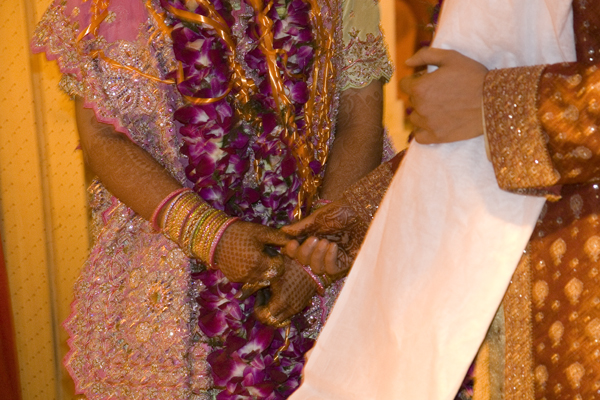
Baraat
This ceremonial procession begins with the groom’s family blessing the groom and putting the turban on his head. This is known as Sehra Bandhi, and after this the groom mounts a decorated white mare. Along with his rejoicing friends and family, the entire Baraat proceeds to the wedding venue. The entire procession is very lively celebration full of music and dance.
Baraat Swaagat
The Baraat is welcomed by the bride’s family at the venue entrance. Typically the male members on bride’s side greet their counterparts in the groom’s family by welcoming them with garlands and embracing them. This is also known as Milni.
Toran
Meanwhile, the groom is escorted by members of the bride’s family. The entrance of the wedding venue is decorated with a toran or flower decorations. The groom hits the toran with a stick before he steps inside the venue.
Bateri Puja
Following the Toran, a welcome prayer or Bateri Puja is conducted, where the groom is showered with blessings and gifts by the father of the bride. The groom gives his word to the father of the bride that he will perform all the sacred rites of marriage according to his prescribed religious duty.
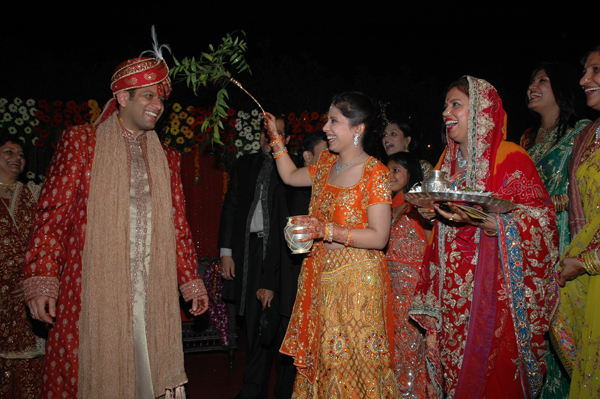
Neem Jhadai
Neem Jhadai
This is a typical Agarwal tradition, where the bride’s sister sprinkles water on the groom with a twig from a Neem tree. Neem tree has many medicinal uses and is hence considered a sacred tree by Hindus. In order to protect her brother-in-law from evil eye and harm, the bride’s sister ceremoniously sprinkles water from the Holy Ganges on the groom. In exchange she gets a small gift from the groom.
Aarti
Mother of the bride honors the groom by performing the traditional Aarti, where she blesses him. She also puts a teeka on the groom’s forehead and wards off evil eye from him.
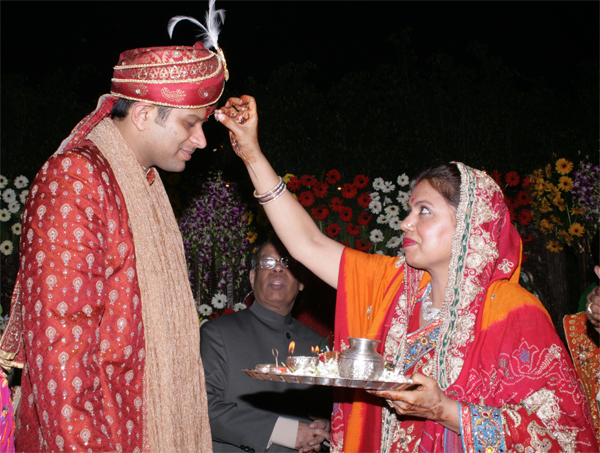
Aarti
Jai Mala
The bride, in all her finery, is escorted to the wedding mandap by her entourage amidst Vedic chants. First, the bride garlands the groom, accepting him as her husband, and the groom reciprocates.
Joota Chhupai
This is the fun part for bride’s sisters and brothers, where they steal the groom’s shoes once he sits for the puja. The shoes are only returned to the groom in exchange for a heavy ransom.

Walking Down the Aisle
Kanyadaan
Kanyadaan is performed by the father of the bride in presence of a large gathering that is invited to witness the wedding. In this ceremony, the father gives away his daughter to the groom. A silver or gold coin is placed in the bride’s palms, which are held together by her father, who then places them in the hands of the groom. Amidst prayers, the pujari pours water over their joined hands and blesses them. The tradition of the groom taking the hand of the bride is also known as Pani Grahan or Hast Milap.
As a condition for giving away his daughter for marriage, the father of the bride requests a promise from the groom for assisting the bride in realizing the three ends : dharma or living life righteously to attain moksha or salvation, artha or money to live life comfortably, and kama or never-ending love and loyalty. The groom makes the promise by repeating three times that he will not fail the bride in his commitment to her and her family.
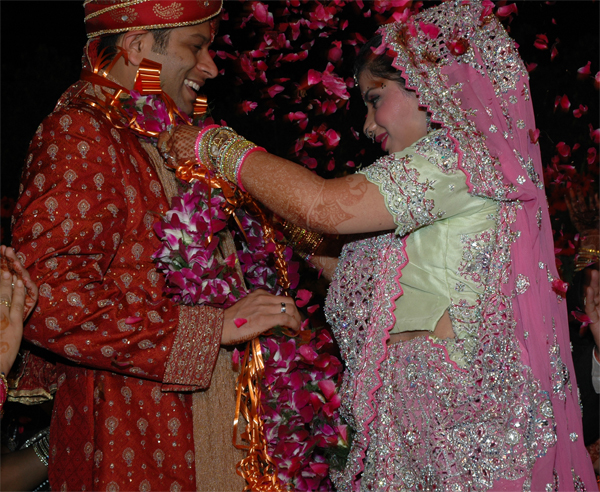
Jaimala
Vachan
After Kanyadaan, the bride asks the groom for certain promises. She, still seated on the right hand side of the groom, asks him for seven vachan or promises which he is required to understand and agree to, in order to have the bride come to his left side and accept being his wife. The vows reiterate the importance of communication, love, and trust in the marriage.
The groom agrees to abide by the vachan. He requests the bride for the same commitment. Once she answers in the affirmative, the bride goes over to the groom’s left where she seats herself. This signifies that from that day forward, she takes the place in and of his heart, which is on the left side of the body.
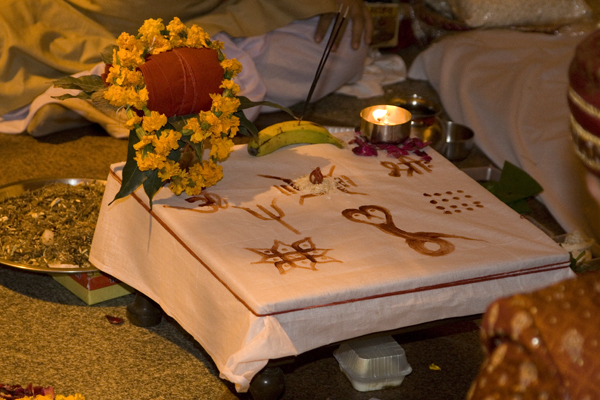
Wedding Puja Preparation
Gath Bandhan and Mangal Pheras
The wedding ceremony is performed in presence of the sacred fire or Agni. Offerings are made into the sacred fire as a form of thanksgiving and purification. The fire also represents the God and a witness or Sakshi to the couple’s marriage. The bride’s veil is tied to the grooms waist band, also known as Gath Bandhan. The couple goes around the fire seven times, repeating their wedding vows amidst the chanting of mantras. Following the pheras, vermilion powder or Sindoor is applied on bride’s forehead and Mangalsutra is put around her neck by the groom. This concludes the wedding rituals.
Aashirwaad
Once the wedding rituals are completed, the couple touches the feet of their parents, elders and ask them for their blessings or Aashirwaad.
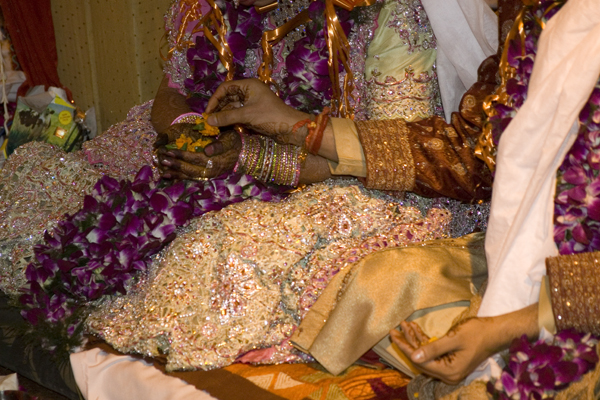
Vachan
Kangana
These are fun games that the couples play right after their ceremony. Kangana, involves untying the sacred red thread, which was tied during Tel Baan on the bride and groom’s wrists. In Jua, the bride’s wedding band is put into a dish filled with milk, untied Kanganas and some grass. The bride and groom dip their hands in the dish to fish for the ring. Mutthi Bandh requires the bride and the groom to make a fist while the other person tries to open it. They both take turns doing this. In Chhand, The groom is asked to recite some verses of poetry in this last game. This is his chance to be creative.
Vidaii
This is a very emotional custom, where the bride bids a tearful farewell to her family to make her way to the husband’s home.
Mooh Dikhai
This is a ritual by which the bride makes her acquaintance with all the members or her husband’s family. When the bride enters her husband’s house for the first time, each member of the family comes in to meet her and shower her with gifts.
As far as rituals are concerned, every community has its own sense of doing things. No matter which community you belong to, weddings are times when the bride and the groom unite with promises for a lifetime. Stay tuned tomorrow for a
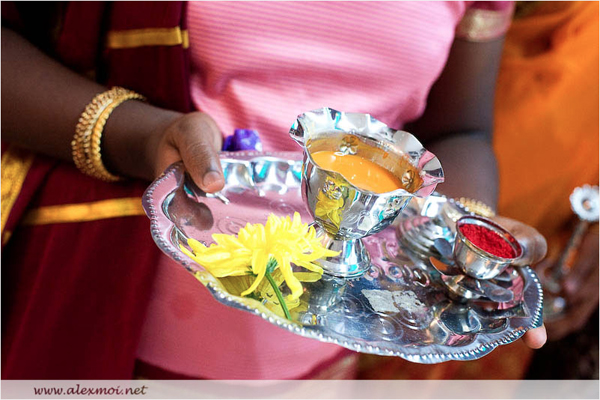 Essentials of a Hindu Wedding Ceremony
Essentials of a Hindu Wedding Ceremony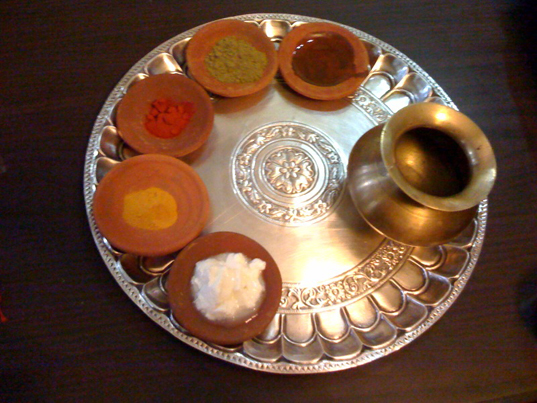 Agarwal Wedding Traditions
Agarwal Wedding Traditions Featured UK Wedding: Nikki + Amish
Featured UK Wedding: Nikki + Amish
Pramod says
The chhand ceremony is very important ceremony in marriage. How could you forgot it. Kindly include it and provide some bindas ‘chhands’ for new dulhas.
Praveen says
Thanks Ms Neha for such a nice description of marriage procedure in our community . Pl continue it for more ceremony such a pug phere & festival formalities.
neha says
Pramod – I will add that soon! I have an interesting story on that from my wedding 🙂
Praveen – I will absolutely add that!